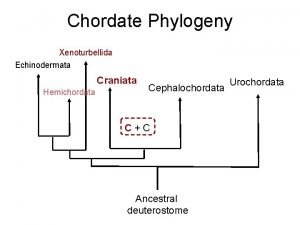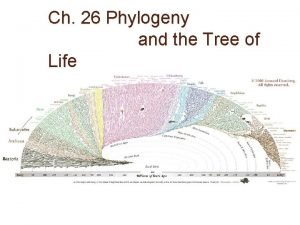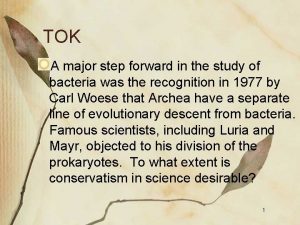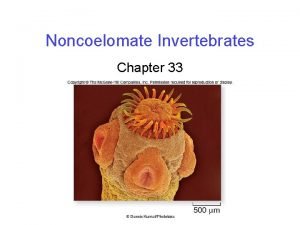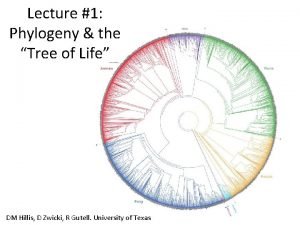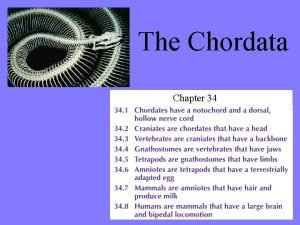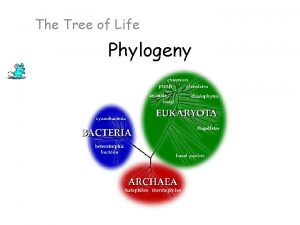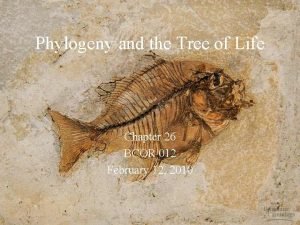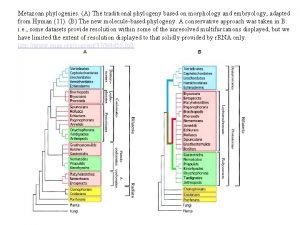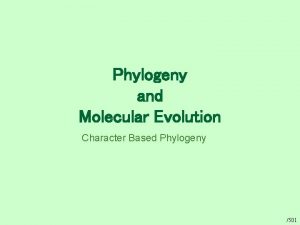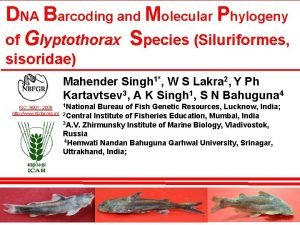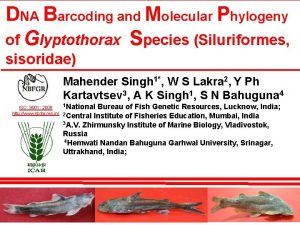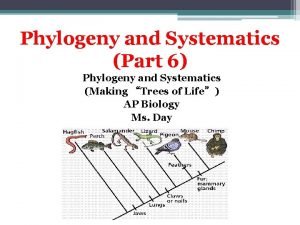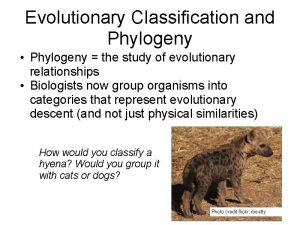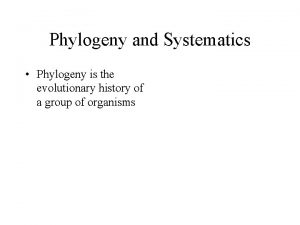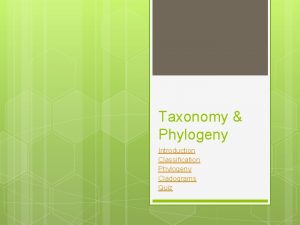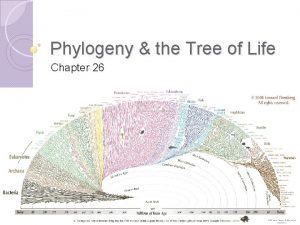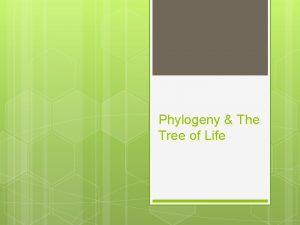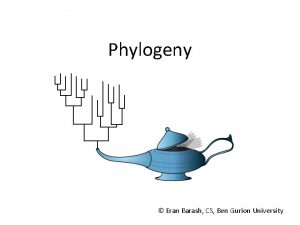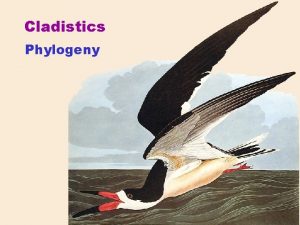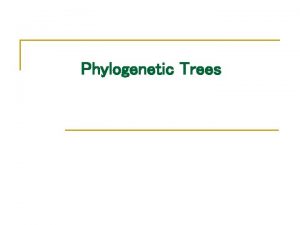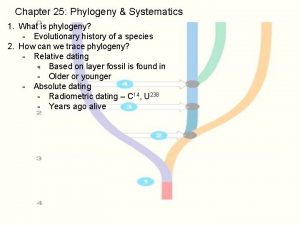MOLECULAR PHYLOGENY OF TEN PLECTRANTHUS SPECIES IN THE

























- Slides: 25

MOLECULAR PHYLOGENY OF TEN PLECTRANTHUS SPECIES IN THE COLEUS CLADE BY Fredrick M. Musila, Lukhoba C. W. , Dossaji S. F. , Nguta J. M. (University of Nairobi)

Economic importance of Plectranthus genus Plectranthus is an extensively used genus in many parts of the world and its uses range from § Medicinal uses/traditional medicine, e. g P. barbatus, P. amboinicus, P. ornatus, P. aegyptiacus, P. montanous § Food uses e. g P. edulis § Horticultural uses P. parvifolius, P. oertendahlii Ethnomedicinal usage of Plectranthus has led to natural product research on specific species of Plectranthus leading to isolation of various bioactive compounds such as Monoterpenes Ditepenes, Flavonoids, Plectranthus species are also used as fodder crops, food additives as well as flavors in many parts of the world due to their aromatic nature e. g P. edulis, P. amboinicus, P. esculentus and P. barbatus

A taxonomic review of Plectranthus belongs to the family Labiatae (Subfamily Nepetoideae, tribe Ocimeae). Plectranthus genus consists of about 300 species distributed in the tropical and warm regions of the world Two clades have been identified with Plectranthus genus: Coleus and Plectranthus clade consists of about 30 species while Coleus clade consists of about 70 species Paton et al. , (2009) further subdivides the Coleus clade into three sub-clades which included Holosytlon (species with an entire style), Solenostemon (species with fused anterior calyx lobes) and Calceolanthus (Species whose calyx throat is surrounded by dense ring of hairs

Taxonomic difficulties in Plectranthus genus ØInitially Plectranthus species were classified using morphological characters only and this led to placement of various species in different families ØCurrently, many species formally classified under Coleus clade have now been placed in Plectranthus clade because initially Plectranthus species were separated generally on the basis of single morphological characters ØIt is also hard to classify species within Plectranthus genus because they are morphologically very similar as there are no clear cut morphological synapormophies.

Furthermore, the genus is faced with a lot of synonymy whereby a species is referred by another name somewhere else Unlike Plectranthus clade, most taxonomic difficulties are observed in the Coleus clade which is well represented in Kenya and which majority of the species are used as medicinal plants (Lukhoba et al. , 2006) Few studies have been published on phylogenetic relationships among Plectranthus species and hence taxonomic relationships among Plectranthus species are not well understood.

• More studies are needed on Plectranthus to investigate whether Plectranthus are monophyletic and to clarify the current classification of Plectranthus species • For example, phylogenetic studies based on molecular characters, biochemical characters and anatomical characters are needed to give insights into Plecranthus classification.

Molecular characters are not influenced by the environment like morphological characters. Molecular characters are better in classifying species which are hard to delimit using morphological characters. With molecular characters, homology assessment is easy and one can easily determine monophyletic groups from the phylogenetic trees produced by molecular characters Hence the current study investigated phylogenetic relationships of ten Kenyan Plectranthus species in the Coleus clade using Rbcl and Mat. K gene sequences

Methodology The following Kenyan Plectranthus species in the Coleus clade were investigated: P. caninus Roth. , P. pseudomarruboides Willemse P. lanuginosus (Hochst. ex Benth. ) Agnew. P. otostegioides (Gürke) Ryding, P. barbatus Andrews, P. montanous Benth, P. ornatus Codd, P. edulis (Vatke) Agnew, P. aegyptiacus (Forssk) C. Chr P. amboinicus (Lour. ) Spreng.

Plectranthus species investigated



Leaves of ten Plectranthus species grouped under the Coleus clade were collected from various geographical regions of Kenya. Following information available in the FTEA on Plectranthus genus and also from already available nomenclatural types in the herbarium, it was possible to identify the specific locality of the species and collect them DNA was extracted from fresh leaves of the collected Plectranthus species using the Cetyltrimethyl Ammonium Bromide (CTAB) DNA extraction method Two chloroplast genes regarded as universal molecular markers suitable for phylogenetic studies for lower taxonomic ranks in plants were targeted and amplified. These genes were: Maturase K gene (Mat. K) and large subunit of the ribulose-bisphosphate carboxylase gene (Rbcl).

The primers were Mat. K-390 (De Mattia et al. , 2011) and Mat. K-1326 R (Amarasinghe et al. 2015) for amplifying the Mat. K gene and Rbcl-1 F (Bruni et al. 2015) and Rbcl 724 R (Li et al. 2011) for amplifying the Rbcl gene PCR products were purified and bidirectionally sequenced. The obtained forward and reverse sequences of the two genes from the 10 Plectranthus species were then exported to MEGA 6 software (Molecular Evolutionary Genetics Analysis) edited and then aligned prior to phylogenetic analysis.

Building of phylogenetic trees • Rbcl and Mat. K phylogenetic trees were constructed in MEGA 6 • The evolution model followed was maximum composite likelihood model while the statistical method used was UPGMA (Unweighted Pair Group Method with Arithmetic Mean) • The test for phylogeny was bootstrap resampling method • The number of boostrap iterations for the sequences was set at 1000 • The following phylogenetic trees were generated.

A phylogenetic tree based on Mat. K gene sequences

A phylogenetic tree based on Rbcl gene sequences

Comparison of Mat. K (a) and Rbcl (b) phylogenetic trees

The two phylogenetic trees are strickingly similar. For example based on the Mat. K genes; P. caninus, P. otostegioides, P. barbatus and P. lanuginosus have been grouped together and all the four species form a monophyletic group. The same pattern can be observed in the phylogenetic tree created using the Rbcl genes. Again based on the Mat. K genes; P. pseudomarruboides, P. ornatus, P. montanous and P. amboinicus have been showed to be closely related. This close relationship of these species can also be observed in phylogenetic tree produced using the Rbcl genes. However based on Mat. K genes, P. aegyptiacus have been shown to be closely related to P. pseudomarruboides and P. ornatus while based on Rbcl genes, P. edulis is closely related to P. amboinicus, P. ornatus, P. pseudomarruboides, P. ambonicus and P. montanous.

Morphological characters described by Paton et al. (2009) in the FTEA for identifying the ten species under investigation Species Succulent leaf Height(m) No. of flowers inflorescence Cymes Pedicels length (mm) Calyx length (mm) Corolla length (mm) Petiole length (mm) Leaf apex bracts Nutlet color Staminal filaments Leaf blade Succulent stem Egrandular hairs P. babatus + 1 -5 10 -14 5 -7 3 -5 8 -26 3 -50 Ob/rd ov/api Brown/bla ck fused El/ov + An/pt P. caninus + 0. 1 -0. 6 6 3 2 3 -5 6 -14 3 -10 Ob/rd ov Grey/blac k Fused El/ov - Rt/pt P. montanous + 0. 4 -2. 5 10 -40 5 -20 2 -3 1. 5 3 -5 0 Ob/rd El/ov Brown/re d free El/obv + Rt/pt P. otosegioides + 0. 3 -0. 5 6 3 6 -7 5 11 -15 3 Ob/rd Obv/El Brown/re d fused Ov/El/O bv _ pt P. lanuginousus + 0. 3 -1 6 -12 3 -6 3 -4 8 -16 5 -30 Ob EL Brown/bla ck fused Triangul ar _ pt P. pseudomarruboides + 1 10 -14 5 -7 1 -3 2 5 -9 1 -15 Ob El Brown/re d free Rhombi c + Rt/pt P. edulis - 0. 3 -1. 2 6 -10 3 -5 2 -3 6 -8 1 -20 Ob/rd ov Brown/bla ck fused Ov _ Unknown P. ornatus + 0. 4 -1. 5 6 3 3 5 -6 14 -22 2 -10 Ob/rd ov Grey/blac k fused El/ov _ An/pt P. aegyptiacus + 0. 5 -2. 5 6 -24 3 -12 3 -10 2 -3 8 -15 5 -20 Ac/rd ov Brown/re d fused Triangul ar _ An/pt P. amboinicus + 0. 3 -0. 5 10 -20 5 -10 -3 3 4 -15 2 -13 Ob/rd Ov/api Brown/re d fused Ov + rt/pt

Based on the morphological characters above, the following dendrogram can be constructed through hierarchical cluster analysis

• Two main clusters/groups are evident from the dendrogram above which occur at about the same horizontal distance. • One cluster (A) contains P. lanuginosus, P. edulis, P. barbatus, P. caninus, P. otostegioides and P. ornatus. • The other cluster (B) contains P. montanous, P. amboinicus, P. pseudomarruboides and P. aegyptiacus. • Cluster A further shows P. lanuginosus, P. edulis, P. barbatus have been grouped together and P. caninus, P. otostegioides and P. ornatus have also been grouped together as well. • Relationships seen in the morphology dendrogram are similar to the relationships of the mat. K and rbcl phylogenetic trees

Findings from previous studies • Plectranthus species have been classified based on their ethnobotanical uses by Lukhoba et al. (2006), they were able group most of the species belonging to Coleus clade together. P. montanous was placed in the same group with P. pseudomarruboides, P. amboinicus was grouped together with P. aegyptiacus while P. barbatus, P. caninus and P. lanuginosus were grouped together. Their findings support the observations in this study • A phylogenetic tree reconstructed by Al-Qurainy et al. (2014) based on nr. ITS also indicates that P. barbatus is closely related to P. caninus while P. amboinicus was closely related to P. montanous. • P. amboinicus was grouped together with P. cylindraceus (syn. P. montanous) and was shown to be distantly related to P. barbatus based on phylogenetic trees reconstructed from three plastid DNA gene sequences: trn. L intron, trn. L-trn. F intergene spacer and rps 16 gene (Paton et al. , 2004). • Such findings by Paton et al. (2004) and Al-Qurainy et al. (2014) supports the Mat. K and Rbcl phylogenetic trees obtained from the current study which has placed P. amboinicus close to P. montanous and P. barbatus close to P. caninus • Grayer et al. (2010) used biochemical characters to classify plectranthus i. e exudate flavonoids and reported that P. pseudomarruboides is closely related to both P. aegyptiacus and P. montanous and this likewise corroborates the findings of the current study.

Recommendation • Further research involving more Plectranthus species within the Coleus and Pletranthus clade should be conducted to better understand their taxonomic relationships. • About 100 Plectranthus species are found in East Africa; seventy of the species belong to the Coleus clade and the rest belong to the Plectranthus clade. • A research on phylogeny based on biochemical characters, molecular and leaf anatomical characters of all the species will help researchers in dealing with the problems of synonymy and place Plectranthus species in their right positions. • Molecular studies will not only involve the use of Mat. K and Rbcl genes but it can also involve the use of other molecular markers in angiosperms such as ndh-F, atp. B, trn. T– trn. L, trn. L–trn. F and atp. B-Rbcl. Methods such as SNPs (Single Nucleotide Polymorphisms), RAPDS (Random Amplified Polymorphic DNA) and RFLPs (Restriction Fragment Length Polymorphisms) can as well be employed to better understand the phylogenetic relationships among Plectranthus genus • A comparison of phylogenetic trees based on various taxonomic characters can be valuable in Plectranthus systematics.

Acknowledgments • DAAD (Germany Academic Exchange Service) • UON

• Thank you
 V. c c
V. c c Các môn thể thao bắt đầu bằng tiếng bóng
Các môn thể thao bắt đầu bằng tiếng bóng Species
Species Giant molecular structure vs simple molecular structure
Giant molecular structure vs simple molecular structure Ionic covalent metallic
Ionic covalent metallic Giant molecular structure vs simple molecular structure
Giant molecular structure vs simple molecular structure Ten twenty thirty
Ten twenty thirty Ten ten siempre fuerzas y esperanza
Ten ten siempre fuerzas y esperanza Ten ten program
Ten ten program Phylogeny
Phylogeny Craniata phylogeny
Craniata phylogeny Crab cladogram
Crab cladogram Homologies
Homologies Phylogeny
Phylogeny Ebi simple phylogeny
Ebi simple phylogeny What is an outgroup in a cladogram
What is an outgroup in a cladogram Closed circulatory system
Closed circulatory system Invertebrate phylogeny
Invertebrate phylogeny #1
#1 Phylogenetic relationship definition
Phylogenetic relationship definition Phylogeny is the study of _____.
Phylogeny is the study of _____. Amniota
Amniota Chapter 20 phylogeny and the tree of life
Chapter 20 phylogeny and the tree of life What is a sister group in phylogeny
What is a sister group in phylogeny Phylogeny and the tree of life chapter 26
Phylogeny and the tree of life chapter 26 Bryozoa
Bryozoa










